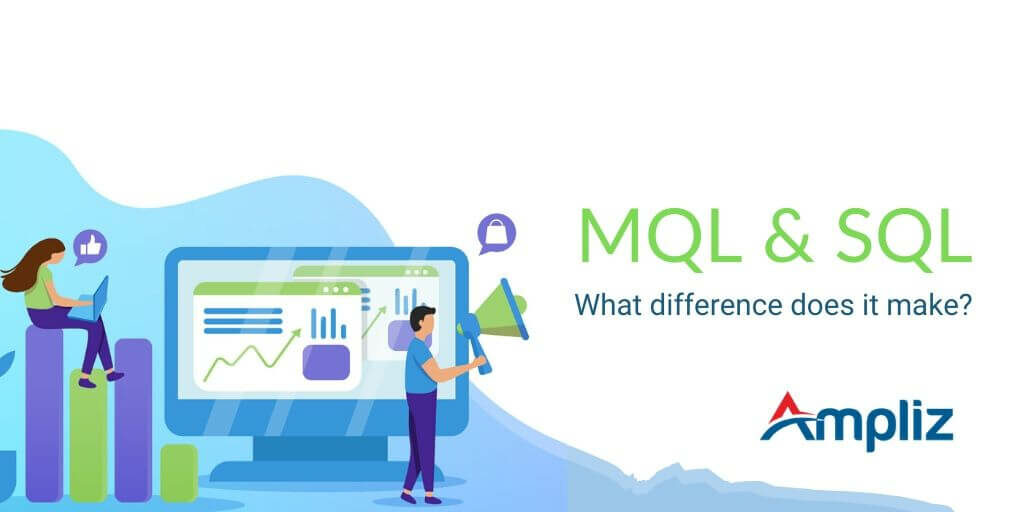MQL vs SQL:
MQL is a lead that marketing deems fit for a sales pitch and is more likely to become a customer. SQL is a lead who has been identified by the sales team as a prospect. MQLs are higher up in the sales cycle, while SQLs are generally at the bottom.
Whether you’re a newbie getting into sales or an experienced marketer, you must’ve come across this age-old tiff about MQL vs SQL. After all, a “lead” is one of the most crucial entities for any business, more so for B2B businesses. You will often hear experienced sales & marketing folks say, “In sales, everything starts with a lead”. This statement couldn’t be more true.
According to HubSpot’s report, 63% of marketers said that generating traffic and leads are their top challenges. Even when they do generate leads, they find it very difficult to tag those leads for a salesperson to convert. It is, thus, crucial to know what MQL vs SQL actually is.
Take this situation as an example. Suppose you have a great website with properly done SEO and all, you’re generating a ton of traffic and thus generating a lot of leads as well. Does the job of the marketing department stop right after generating B2B leads? If your answer is yes, then it implies that the leads should have a 100% conversion rate.
But in reality, that figure is way too low. This is where identifying “qualified leads” come into existence. In this article, we’ll not only educate you about the difference between MQL vs SQL but also take you through the whole journey of MQL to SQL conversion.

MQL vs SQL: What is the difference?
Okay, let’s address the elephant in the room now, shall we?
As we mentioned earlier, an MQL (marketing qualified lead) is a lead that marketing deems fit for a sales pitch and is more likely to become a customer. Now, who gets to decide whether a lead is fit to be pitched or most importantly, on what basis does this get decided?
Well generally, the person in the marketing team responsible for analytics takes up this job. However, if it’s a small team, then the SEO guy takes the call. How do you measure the readiness of a lead then? – based on lead behavior. Certain factors like website visits, Mofu “lead magnet” downloads, belonging to a particular cohort, engagement with “conversion” CTAs, et cetera, help in deciding whether a lead can be qualified as an MQL.
On the other hand, SQL (sales qualified lead) is the next step where the sales team qualifies this lead as a prospect or a potential customer. A sales qualified lead is in the sales process as compared to a marketing qualified lead, which is yet to enter that cycle. Let’s break it down for you in a much simpler form.
The passing of MQLs to sales teams is often done via closed-loop reporting.
Website visitor> Lead > MQL > SQL > Customer
Here’s an image of the same to help you understand better!

This process or journey is often termed as MQL to SQL conversion.
What is MQL to SQL conversion, you ask?
MQL to SQL conversion or process is simply the journey of a lead from getting qualified by marketing to getting qualified by sales. You might have heard a lot of people ask about the conversion rate.
So, what exactly is MQL to SQL conversion rate?

It is the percentage of marketing qualified leads that get qualified by the sales folks. This metric is used to analyze the efficiency of a marketing team in qualifying leads and maintaining a healthy sales pipeline for the salespeople.
What is an MQL (Marketing Qualified Lead)?
An MQL is a prospect that is invested in and investigated by the marketing team. He has an interest or need for your product or service. Identifying an MQL in the early stage of the customer journey can get you closer to converting it to a sales qualified lead.
The journey of an MQL starts from visiting your website, signing up for newsletter(probably), going through the product page, and inquiring about your product or service. These activities of a visitor clearly show the sign of his interest in your product and services. This is one of the characteristics which differentiates an MQL in the debate of MQL vs SQL.
Moreover, once the marketing team finds a lead who’s spent a considerable amount of time on your website, it becomes quite easy to qualify it as an MQL. However, tagging a lead as MQL doesn’t necessarily mean that it will turn out to be a customer.
So, how do you define a qualified lead in marketing?
- The lead has demonstrated some level of engagement in one or more ways if it has:
- Interacted with your website for a considerable amount of time
- Signed up for your newsletter
- Submitted personal details for some Mofu or Lofu lead magnet
- Lead has visited “money pages” on your website, etc.
- The lead belongs to a highly active cohort (cohorts being formed for several marketing activities)
- That person might have shown interest in any of your product pitches/outreach programs/cold emails, etc.
The aforementioned points are just a mere overview of how a marketing team can/may qualify leads. After the qualification is done, it is handed over to the sales team.
By the way, if you’re wondering how do you generate qualified leads in marketing, we have a sleek blog post on it. Check it out!
Now the obvious next step is for a sales team is to engage with the MQL, see if it can be qualified for sales and identify an opportunity.
But, there is a small step before that. This step is called “accepting a lead by the sales team” or converting the MQL into a sales accepted lead.
What is a sales accepted lead (SAL)?
Sometimes, there is a transition phase involved in the MQL to SQL process. Before the MQL can be handed over to the sales team, it has to meet certain pre-set criteria. When these criteria are met, the MQL gets transitioned into a SAL or a sales accepted lead.
Wondering why is this step necessary? I mean, does this step not increase the friction in the whole MQL to SQL process? Well, there are a couple of reasons.
Here are 3 reasons why a sales team might reject a marketing qualified lead(s);
- Inaccurate data about the lead
- Doesn’t fit the buyer persona (might have requirements that the product/service you’re selling can’t fulfill)
- The lead is premature, i.e, it still needs some lead nurturing
Due to the above-mentioned reasons, a sales team might not accept a lead that has been passed on by the marketing team. If however, the prerequisites are met, the lead will be termed as a sales accepted lead (SAL) and then the further steps will begin.
What is an SQL (Sales Qualified Lead)?
A Sales Qualified Lead (SQL) is a prospective customer, researched, and nurtured by the marketing team, who has shown some intent in buying your product/service. Once the requirement of a prospect is investigated and understood, and your product addresses his need, he becomes a Sales Qualified Lead.
An interesting study by Marketo states that almost 61% of B2B marketers transfer all of the leads’ information to the sales team, where only 27% are qualified. It is one of the prominent reasons for abysmal conversion rates.
Once an MQL has been converted to a SAL, the sales team starts engaging with the lead. If they find the lead to be good enough to be a prospect after delivering their sales pitch and interacting with them, they qualify it into a sales qualified lead. The tagging a lead as an SQL is followed by identifying an opportunity and finally closing the sales. That’s the ideal journey of an MQL to SQL.
Lead nurturing plays a big part in this whole process
You see, this entire process that we discussed above is not that simple. I mean, just look at the number of steps involved in this whole situation, right from generating a B2B lead to closing it. Qualifying leads is not at all easy. And even if you do qualify leads with sheer ease, nurturing them is quite important.
Lead nurturing is the process of fostering a lead in every way possible in order to push it down the sales funnel. It is absolutely imperative to nurture leads by the marketing folks, once they have qualified them.
There can be a lot of ways a lead can be nurtured. Here are a few:
- Email marketing
- Retargeting via social media Ads
- Sending over e-books or templates (content marketing)
Where does lead scoring fit in the sales funnel?
Lead scoring is a way of assigning values (generally, numeric) to qualified leads in order to identify which ones are more prone to be converted into paying customers. Scoring leads ensure that the sales team divides its effort based on the likeability of a particular lead’s conversion.
As far as the sales funnel is concerned, lead scoring generally kicks in after the SQL stage and before the conversion stage.

The alignment of the sales and marketing teams is very crucial
According to the CMO agenda report, aligning the sales and marketing team can bring you:
- 32% higher revenue
- 36% more customer
- 38% higher win rates
Also, it is found by Sirius Decision that 1 in 4 companies achieved a faster growth rate, and 27% had increased their profits in a year by aligning their sales and marketing teams.
The alignment of the sales and marketing team increases transparency, comfort, and gives each side ample freedom and responsibility for taking decisions on customer profiles.
From MQL to SAL to SQL the alignment of both the marketing and sales team is crucial.
Key Takeaways
- MQL vs SQL: There’s a huge difference between both the terms.
- What is MQL in marketing?
It is a lead that the marketing team deems fit to be handed over to the sales team. - MQL full form – MQL stands for marketing qualified leads
- The MQL to SQL conversion process is more complex than it appears to be
- SAL or sales acceptance lead – This stage precedes the SQL stage
- SQL full form – SQL stands for Sales qualified leads
- Lead nurturing is very important in order to push a lead down the sales funnel
- Salespeople should definitely score leads to make sure better leads get more of their time and effort.
- The alignment of sales and marketing teams is crucial for success.
- The journey of a website visitor to a paid customer is somewhat like:
Subscriber> Lead > MQL > SAL > SQL > Opportunity > Customer




